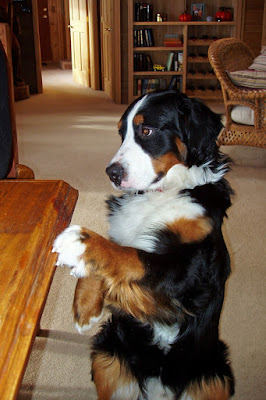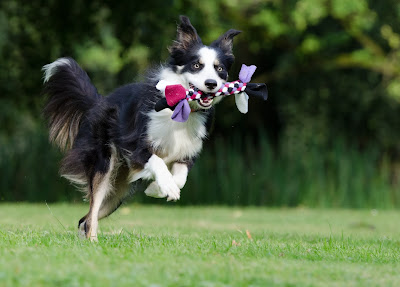Some breeds are more susceptible to becoming too heavy than others. German shepherds and Dobermann pinschers will easily maintain their weight. On the other hand, Rotweillers and St. Bernards will easily pack fat on.
The Obesity Indicator in Dogs
Of course, checking to see if your dog is eyeing XXXXXL bikinis when at the mall is no indication of any weight problems. While dog sizes vary from breed to breed, there is a fairly universal way of judging whether your canine is howling the heavy song.
The first method is by simply looking. A normal-weight dog should have a defined rib cage, abdomen and hip area. In dogs with normal weight, the rib cage and hip areas are bigger than the abdomen when viewed from above while the dog is standing. If it is just one blob of canine then no matter how much you convince yourself, your dog has packed too much fat.
You can also just feel your dog with your fingers. Run your fingers across the rib cage with reasonable pressure as if trying to count the ribs. If your are able to feel the bones then you pet is of a healthy weight. If all you feel is dog with no bone, you just got yourself a new task- shedding off some dog weight. Note that you have to feel the ribs and not see them.
So now that you have cross-examined your dog and found it guilty, it’s time to sentence it. But this is by no means a punishment. Keeping your dog within the normal weight will be in its best interest.
How to manage an overweight dog
As with people, the basic reason dogs will become too heavy is the disproportionate intake of calories, that is consuming more than they burn. A dog which gains weight will become less active which will lead to more weight. More weight will eventually turn it into one cuddly lazy canine with a horde of health risks.
The key is knowing how much your dog needs to consume. You can consult your vet who will determine the right amount of food by considering the age, breed and general health condition of your dog. Once you have the right amount of food, stick to it and do not revert to your old canine-destroying feeding deeds. Come up with a plan which should include the right food for overweight dogs, in the right amounts at the right time.
It helps to make it clear to the family and even friends that your dog is on weight-watch because even little, seemingly harmless treats may set you on a treadmill.
What if the poor dog begs?
Of course, if the dog finds itself eating less than it's accustomed to, it may resort to begging and scouting for food here and there. But no matter how heartless it may seem to ignore its begging whimpering and poses, keep to your program- it will be more heartless to give in. The best way to reduce the occurrence of these begging sessions is by feeding your canine friend the same time your family eats. Your dog won't beg for what it hasn't seen- unless it's. .. . a psychic dog?
Exercise to Manage Dog Weight
By implementing a diet scheme and an exercise routine, you will be burning the candle of obesity in your canine from both ends. 'Exercise routine' here has nothing to do with pumping metal, skip ropes or steroids. Just a simple calm walk in the park or over to a friend's place will do. You can also go on reasonably paced jogs with your dog so long you don't overdo it.
There are also dog toys that you can use to keep your dog happily busy. Even simple chewing ropes will do as they will burn calories without adding any as the dog tries to chew them. Try to let your dog earn it's rationed treats by performing some activity. Like put the food in a difficult place and let the dog reach for it. It will be fun for both you and your dog. Don't overdo this and go putting bones on a dog-sized mouse trap.
Medication For Weight Management in Dogs.
The above methods for dog weight loss are fairly natural. But there is also medication which aims at the same goal but it is vigorously-shaking-head not recommended unless suggested by the vet. It can have negative side effects on your pet and should only be used if all other means fail.
How long Before Any Change?
As with anything, the time it will take to see results will depend on you and your dog's input- which means you because the dog is under your guidance. Within 2 weeks, changes should begin to appear. It is essential to note your dogs progress. Take down its weight every week to see the direction of the graph. Just get on a scale and note your weight. Then get hold your dog and get on the scale. By kindergarten math, subtracting your weight from your and your dog's combined weight will give you the canine's weight. Feeling smart, Einstein?
Keeping your dog's weight in check will keep a lot of medical problems at bay. The whole process may unearth the presence of diseases like Hypothyroidism




No comments:
Post a Comment